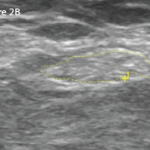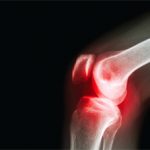
Long-Term Benefits of Induction Therapy for GCA
Induction therapy with high intravenous doses of methylprednisolone suppresses inflammation and hastens remission in patients with giant cell arteritis (GCA), according to a new study in Arthritis & Rheumatism (2006;54(10):3310-3318).
Perhaps the most important finding was that the induction therapy had long-term benefits with a higher frequency of patients in sustained remission off treatment and less smoldering disease after one year, senior author Jorg J. Goronzy, MD, PhD, professor of medicine at Emory University School of Medicine in Atlanta, tells The Rheumatologist.
In the study, 27 patients with biopsy-proven GCA were randomized to receive daily infusions of methylprednisolone in a dose of 15 mg/kg or a saline placebo for three days. All patients also took oral prednisone, starting with a dose of 40 mg/day and tapering as long as disease activity was controlled. After the infusions, the patients were followed every four weeks by physicians who were blinded to each patient’s infusion status. They reported their findings at 36, 52, and 78 weeks after the start of therapy.
For all patients, the mean erythrocyte sedimentation rate and C-reactive protein values returned to normal by the first four-week follow-up visit. This was unexpected, given that the doses were lower than those conventionally recommended, says Dr. Goronzy.
This suggests that patients without evidence of severe vascular manifestations could do well initially with a lower dose and more rapid tapering of prednisone. However, without methylprednisolone induction therapy, the disease may smolder and require a higher cumulative dose of oral prednisone to keep it under control, says lead author Mehrdad Mazlumzadeh, MD, assistant professor of medicine at the Mayo Clinic in Scottsdale, Ariz.
Ten of the 14 patients (71%) who received methylprednisolone achieved the primary outcome of staying in remission at 36 weeks on oral prednisone in doses of 5 mg/day or less, compared with only two of the 13 (15%) control patients (p=0.003). Six patients in the methylprednisolone group were off treatment entirely by the three-week point, compared with none of the control patients.
What’s more, patients who received the methylprednisolone required much lower median doses of oral glucocorticoids at every follow-up period. Over the length of the study, they took a median of 5,636 mg of prednisone, compared to a cumulative median of 7,860 mg taken by patients in the control group (p=0.001). The relapse rate was also significantly lower among patients in the IV glucocorticoid group, although there was no significant difference in the rate of adverse effects.
“It was interesting to see that the disease could be initially controlled with relatively little steroid in the control group,” adds Dr. Goronzy, “but this may come at the price of more smoldering disease in the second year,” an observation that he says should be confirmed in a larger study.

Exercise Prior to Arthroplasty Increases Chances of Home Discharge
A patient’s chance of being discharged directly home after major joint arthroplasty increases significantly when the patient engages in a presurgical exercise program, according to a study published in Arthritis Care & Research (2006;55(5):700-709).
The magnitude of the exercise effect was “startling,” lead author Daniel S. Rooks, ScD, assistant professor of medicine at Harvard Medical School in Boston, tells The Rheumatologist.
The potential role of exercise in preparation for joint replacement surgery has received little attention, Dr. Rooks and his coauthors write. They studied the impact of a six-week preoperative exercise program on postoperative function, pain, and muscle strength among people undergoing primary, unilateral total knee or hip arthroplasty.
The authors enrolled 63 patients scheduled for total hip arthroplasty and 45 for total knee arthroplasty. Patients randomized to the exercise program performed cardiovascular, strength, and flexibility exercises three times a week for the six weeks prior to surgery. Patients in the control group received educational handouts in the mail and weekly follow-up phone calls. All participants were evaluated on pain, functional status, and muscle strength at baseline, after the six-week intervention period, and at eight and 26 weeks after surgery.
Sixty-five percent of the patients who exercised were discharged directly to home following surgery, compared with 44% in the control group. The remaining patients were discharged to a rehabilitation facility. All in all, exercisers were 73% more likely to be discharged to home, compared with the controls. “I think that participating in the exercise program helped people physically and mentally prepare for in-hospital rehabilitation immediately following surgery, which enabled them to be better prepared to manage their health at home,” says Dr. Rooks.
Physical function improved significantly among patients scheduled for total hip arthroplasty by the end of the six-week exercise period, while it worsened in the control patients. Total knee arthroplasty exercisers demonstrated a 20% increase in leg-press strength compared with the controls, but this did not translate into a corresponding improvement in function or decrease in pain, suggesting that the outcomes depended to some extent on joint location, the authors write.
Nevertheless, by postoperative week 26, muscle strength had increased by 32% over baseline in the total hip arthroplasty and total knee arthroplasty patients who exercised versus 8% in the control group.
Only 12% of the patients invited actually participated in the study, and dropout rates were relatively high. This could reflect the fact that the exercise program was offered at only one site and was probably not convenient for many people. This demonstrates that “convenience and accessibility are very important considerations when designing an exercise intervention program,” notes Dr. Rooks.
Norra MacReady is a medical journalist based in southern California.


